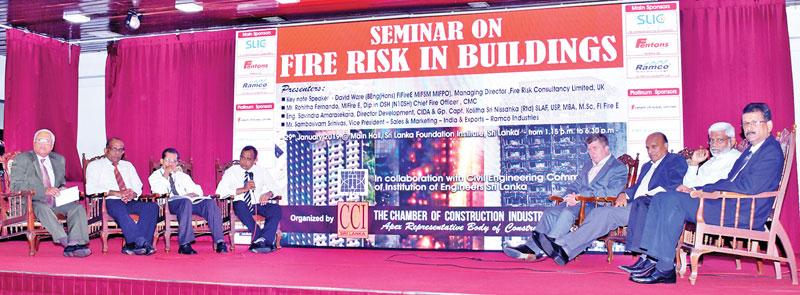
A supportive regulatory framework is necessary to meet the changing needs of the construction industry, an international fire risk expert said at a seminar on fire risk in high rise buildings organised by Chamber of Construction Industry Sri Lanka in collaboration with Civil Engineering Committee of Institute of Engineers Sri Lanka held last week in Colombo.
“The existing laws related to high rise buildings need to be updated and amended to accommodate the evolving needs of the modern construction sector. As the construction industry landscape has changed tremendously over the past few years, it is necessary to incorporate relevant laws to meet the industry requirements,” Managing Director Fire Risk Consultancy Limited, UK, David Ware said.
He was speaking on ‘The future of fire safety in high rise buildings - lessons learnt from Grenfell tower disaster’.
There is a need to have accessibility and facilities for fire services in the newly constructed high rise buildings. It is also necessary to conduct inspection of flats from time to time. The ‘Stay put’ policy which is in operation in the UK which was highlighted at the Grenfell tower disaster, indicated the need for protection and compartmental requirements in a High Rise buildings, he said.
A ‘stay put’ policy is based on the theory that buildings can be designed to prevent fire spreading, so a blaze in one flat should not be able to spread to another. But expert reports submitted to the inquiry suggest that, since 1974, major changes to Grenfell Tower destroyed that protection.
The regulatory requirements in the principal stages of a building are - planning, construction, use, maintenance, alterations and extensions, change of use and demolition when empty. The Document is an important work on structural requirements of planning, Chief Fire Officer Colombo Municipal Council, P.M.R. Fernando said. He spoke on the topic ‘Applicable fire regulations and role of Colombo Municipal Council in mitigating fire risk’.
Among the structural and access requirements are - protected stairways, alternative means of escape, fire fighting shaft, compartmentalisation and a fire command centre. A high category of buildings could be classified under low rise, medium rise, high rise and super high rise (which are 60 meters and above).
The nature of occupancy ranges from residential apartments, buildings other than residential apartments and car parks. The fire safety requirements for buildings under construction are fire service access, fire fighting facilities, means of escape, fire detection and warning equipment, action plan on an event of fire and fire drills, he said.
The role of the CMC Fire Service in mitigating fire risk is supported by the fire prevention section, operation and training sector. Among the services to the community are fire calls, rescue calls, emergency calls, 110 ambulance calls, humanitarian and social services and VIP duty.
In Sri Lanka, the number of fire calls is low compared to other countries, due to the high level of fire (protection) policies, he said.
